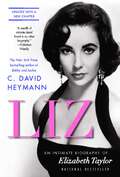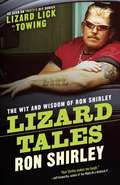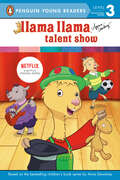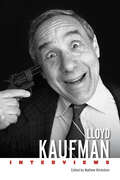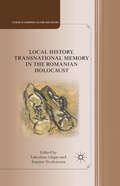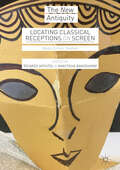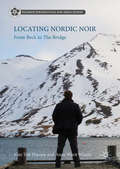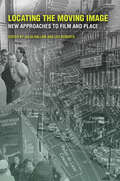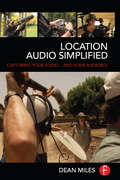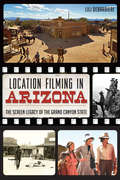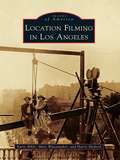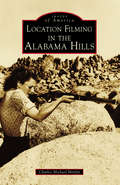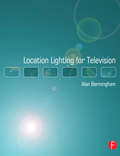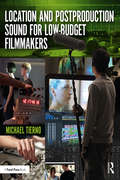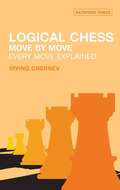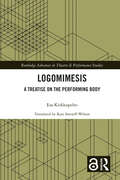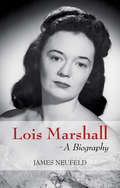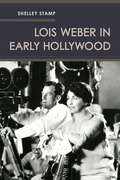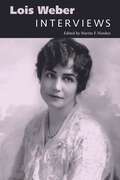- Table View
- List View
Living the Lighting Life: A Guide to a Career in Entertainment Lighting
by Brad SchillerLiving the Lighting Life provides practical tools and advice for a successful career in entertainment lighting. This easy-to-navigate guide offers real-world examples and documentation from the author and key industry experts, giving readers a comprehensive overview of the lighting life. The book provides insight on: Different job opportunities in the entertainment lighting industry; Business procedures, contracts, time sheets, and invoices; Tips on self-promotion, networking, and continual learning; The lighting lifestyle, healthy living, and work-related travel; Maintaining and developing creativity to provide innovative lighting and solutions. With insightful interviews from industry veterans, Living the Lighting Life is a key navigational resource for anyone considering a career in entertainment lighting or just starting out.
Living the Lighting Life: A Guide to a Career in Entertainment Lighting
by Brad SchillerLiving the Lighting Life provides practical tools and advice for a successful career in entertainment lighting. This easy-to-navigate guide offers real-world examples and documentation from the author and key industry experts, giving readers a comprehensive overview of the lighting life. The book provides insight on: Different job opportunities in the entertainment lighting industry; Business procedures, contracts, time sheets, and invoices; Tips on self-promotion, networking, and continual learning; The lighting lifestyle, healthy living, and work-related travel; Maintaining and developing creativity to provide innovative lighting and solutions. With insightful interviews from industry veterans, Living the Lighting Life is a key navigational resource for anyone considering a career in entertainment lighting or just starting out.
Liz: An Intimate Biography of Elizabeth Taylor (updated with a new chapter)
by C. David HeymannElizabeth Taylor's own story was more dramatic than any part she ever played on the screen. C. David Heymann brings her magnificently to life in this acclaimed biography--updated with a new chapter covering her final years.She was an icon, one of the most watched, photographed, and gossiped-about personalities of our time. Child star, daughter of a controlling stage mother, Oscar-winning actress, seductress and eight-time wife, mother of four children and grandmother of ten, champion of funding for AIDS research, purveyor of perfumes and jewelry, close friend of celebrities and tycoons—Elizabeth Taylor, for almost eight decades, played most completely, beautifully, cunningly, flamboyantly, and scandalously her greatest role of all: herself.The basis of an Emmy Award-nominated miniseries, Liz portrays Taylor’s life and career in fascinating, revealing detail and includes an additional new chapter, bringing her beloved fans up to date on her final years. By way of more than a thousand interviews with stars, directors, producers, designers, friends, family, business associates, and employees and through extensive research among previously disclosed court, business, medical, and studio documents, bestselling author Heymann reminds readers of her very public escapades and unveils her most private moments.Here are the highs and lows of her film career and the intimate circumstances of her marriages to Nicky Hilton, Michael Wilding, Mike Todd, Eddie Fisher, Richard Burton, Senator John Warner, and Larry Fortensky. Here, too, is the truth about Taylor’s father and her friendships with leading men Montgomery Clift, James Dean, and Rock Hudson, as well as with the eccentric Malcolm Forbes and Michael Jackson. From her illnesses, injuries, weight issues, and battles against drug and alcohol, to her sexual exploits, diamond-studded adventures, and tumultuous love affairs, this is the enormously contradictory and glamorous life of Hollywood’s last great star.
Lizard Tales: The Wit and Wisdom of Ron Shirley
by Ron ShirleyThe star of TruTV's hit show, Lizard Lick Towing, shares stories of life as a small-town repo man, as well as the "Ron-isms" and "Ron-osophy" he is known for.Crazier than a sack of rabid weasels?Country as cornflakes?Gooder than grits?You bet he is! Week after week, millions of viewers tune in to Lizard Lick Towing to watch Ron Shirley outsmart the fist-swinging, gun-toting folks whose vehicles he's been hired to repossess. Staring danger in the face, Ron disarms them not with his size or his strength but with his wit--and especially with his trademark funny sayings that have come to be known as "Ronisms." In Lizard Tales, Ron takes readers on a side-splitting trip through his wacky, colorful life. Growing up and raising heck in the Carolina countryside--where sushi is still called "bait"--young Ronnie was known to gig frogs, mooch moonshine from his pops, hunt, and cruise the strip in Myrtle Beach. He continues to get himself into hilarious scrapes and jams as an adult by tarring a roof during a lightning storm, inviting an angry deer onto his cousin's brand-new boat, drinking (and fist-fighting) with a priest, matching wits with his wife, Amy, and running repo with his sidekicks at the towing company. So kick back, help yourself to some 'shine (if you got it), let Ron tell you some stories, and prepare yourself to get licked!From the Trade Paperback edition.
Llama Llama Talent Show (Llama Llama)
by Anna DewdneyA Level 2 Reader based on an episode of Llama Llama's animated Netflix television series, perfect for little ones developing their own talent--for reading!Look out, world--Llama Llama is a TV star! The beloved character, made famous by Anna Dewdney's best-selling picture books, is the star of his own original series, now airing on Netflix. In this episode-based leveled reader, Llama Llama and his friends prepare acts for the school talent show, but Llama Llama doesn't know what act to perform! Your little llamas will love relating to their favorite character as he faces new and challenging situations.
Lloyd Kaufman: Interviews (Conversations with Filmmakers Series)
by Mathew KlicksteinAfter nearly fifty years of disrupting media, gleefully Rabelaisian uberindie filmmaker Lloyd Kaufman (b. 1945) has been maligned, mocked, and—worst of all—ignored throughout the general course of his wildly eclectic and impactful filmography. As the equally huckster-ish and self-denigrating cofounder and president of Troma Entertainment—responsible for the likes of such schlocky “midnight movie” fare as The Toxic Avenger, Sgt. Kabukiman N.Y.P.D., Surf Nazis Must Die, Class of Nuke ’Em High, Tromeo & Juliet, and, most recently, #ShakespearesShitstorm—Kaufman has indisputably left his slimily viscous fingerprints on moviemaking throughout the past half century. Lloyd Kaufman: Interviews gathers together no-holds-barred commentaries, op-eds, Q&As, arguments, and retorts from the prodigious filmmaker. Considering the typical Troma film is known, if at all, for the brand’s signature egregious gore, unabashedly scandalous sexual fetishism, sophomoric scatology, and provocative contrarianism, it’s easy to understand why Kaufman and his (still metastasizing) oeuvre go without much notice in the mainstream trades or classroom discussions. Like a modern-day P. T. Barnum, if there’s one way that Kaufman finds a pragmatic hold on the cultural zeitgeist, it’s through his tsunamic deluge of often vivacious, often vulgar, often vicious, and often (most dangerous of all) presciently insightful speaking engagements and interviews provided at an almost manic pace across the globe. Complete with an exclusive interview conducted by volume editor Mathew Klickstein, Lloyd Kaufman: Interviews is an extensive deep-dive omnibus from one of cinema’s most indefatigably ardent auteurs who may make us all uproariously laugh but refuses to not be taken deadly seriously.
Local Hero: Making a Scottish Classic
by Jonathan MelvilleIt's not a high concept movie, there's actually no story there really. It’s what happens in between the story that’s important' – Bill Forsyth The story of an American businessman sent to buy the Scottish village of Ferness with the aim of turning it into an oil refinery, Local Hero is one of Scotland’s most beloved, and most misunderstood, films. When Bill Forsyth’s incredible success with the low-budget That Sinking Feeling and Gregory’s Girl found him collaborating with Britain’s best-known film producer, David Puttnam, he soon found his independent ethos clashing with Hollywood’s desire for superstar actors and a happy ending. Jonathan Melville checks into the MacAskill Arms and looks back at Bill Forsyth’s career with the help of new and archive interviews, before spending time with the cast and crew, including stars Peter Riegert and Denis Lawson, who made Local Hero on location in Houston and Scotland in 1982. With access to early drafts of the Local Hero script (including hand-written notes) that reveal more about Mac and mermaids, excerpts from a previously unpublished interview in which Bill Forsyth explains why he refuses to call his film 'feel-good', and a look at long-lost deleted scenes with exclusive commentary from those involved, this is the definitive history of the Scottish classic. ‘Genuine fairy tales are rare; so is film-making that is thoroughly original in an unobtrusive way. Bill Forsyth's quirky disarming Local Hero is both . . . it demonstrates Mr. Forsyth's uncanny ability for making an audience sense that something magical is going on, even if that something isn't easily explained’ – Janet Maslin, The New York Times 'Local Hero is kind of transcendent. It's poetic in a way that most films can't hope to be' – Frank Cottrell-Boyce 'Local Hero is one my favourite films of all time . . . A timeless masterpiece' – Mark Kermode
Local History, Transnational Memory in the Romanian Holocaust
by Valentina Glajar Jeanine TeodorescuThis book explores the memory of the Romanian Holocaust in Romanian, German, Israeli, and French cultural representations. The essays in this volume discuss first-hand testimonial accounts, letters, journals, drawings, literary texts and films by Elie Wiesel, Paul Celan, Aharon Appelfeld Norman Manea, Radu Mihaileanu, among others.
Local Radio, Going Global
by Guy StarkeyAn examination of the development of local radio broadcasting and the trend for locally-owned, locally-originated and locally-accountable commercial radio stations to fall into the hands of national and international media groups. Starkey traces the early development of local radio through to present-day digital environments.
Locating Classical Receptions on Screen: Masks, Echoes, Shadows (The New Antiquity)
by Anastasia Bakogianni Ricardo ApostolThis volume explores film and television sources in problematic conversation with classical antiquity, to better understand the nature of artistic reception and classical reception in particular. Drawing inspiration from well-theorized fields like adaptation studies, comparative literature, and film, the essays in this collection raise questions fundamental to the future of reception studies. The first section, ‘Beyond Fidelity’, deals with idiosyncratic adaptations of ancient sources; the second section, ‘Beyond Influence’, discusses modern works purporting to adapt ancient figures or themes that are less straightforwardly ancient than they may at first appear; while the last section, ‘Beyond Original’, uses films that lack even these murky connections to antiquity to challenge the notion that studying reception requires establishing historical connections between works. As questions of audience, interpretation, and subjectivity are central to most contemporary fields of study, this is a collection that is of interest to a wide variety of readers in the humanities.
Locating Nordic Noir
by Anne Marit Waade Kim Toft HansenThis book is a comprehensive study of Nordic Noir television drama from the 1990's until today. The authors introduce the history of contemporary Nordic Noir from the perspective of place, production and location studies. The chapters include readings of well-known television crime dramas such as Beck, The Killing, Trapped and The Bridge as well as a range of other important Nordic Noir cases. The authors position the development of Nordic Noir in the global market for popular television drama and place the international attention towards Nordic crime dramas within regional development of drama production in Sweden, Denmark, Norway and Iceland. Consequently, Nordic Noir is read as both a transnational financial and creative phenomenon and as a local possibility for community building. Offering a comprehensible, scholarly and methodologically original approach to the popularity of Nordic television crime dramas, this volume is aimed at readers with an in terest in crime drama as well as scholars and students of television drama.
Locating the Moving Image: New Approaches to Film and Place (The Spatial Humanities)
by Julia Hallam and Les RobertsEssays exploring the methodologies used by film scholars to develop a spatial history of the moving image.Leading scholars in the interdisciplinary field of geo-spatial visual studies examine the social experience of cinema and the different ways in which film production developed as a commercial enterprise, as a leisure activity, and as modes of expression and communication. Their research charts new pathways in mapping the relationship between film production and local film practices, theatrical exhibition circuits and cinema going, creating new forms of spatial anthropology. Topics include cinematic practices in rural and urban communities, development of cinema by amateur filmmakers, and use of GIS in mapping the spatial development of film production and cinema going as social practices.“Introduces some of the concrete ways practical mapping and GIS technologies help elaborate historical film projects. . . . The scope of many of these projects is breathtaking in scale. . . . Others embrace ethnographic methods that tell poignant individual stories. Still others deftly merge qualitative and quantitative approaches. . . . As a whole, the volume brings together disparate fields of study in interesting ways.” —James Craine, California State University, Northridge“This collection breaks new ground for cinema history. Hallam and Roberts have gathered some of the foremost scholars who are mapping spatial histories of the moving image and the geographies of film production, distribution and consumption. Introducing new interdisciplinary methods and asking new questions, Locating the Moving Image takes film studies into new territory, beyond the boundaries of the text and its interpretation, towards an understanding of the relationship between culture, spatiality and place.” —Richard Maltby, Matthew Flinders Distinguished Professor of Screen Studies, Flinders University
Location Audio Simplified: Capturing Your Audio... and Your Audience
by Dean MilesFrom the basics of using camera, handheld, lavalier, and shotgun microphones to camera calibration and mixer set-ups, Location Audio Simplified unlocks the secrets to clean and clear broadcast quality audio no matter what challenges you face. Author Dean Miles applies his twenty-plus years of experience as a professional location operator to teach the skills, techniques, tips, and secrets needed to produce high-quality production sound on location. Humorous and thoroughly practical, the book covers a wide array of topics, such as:* location selection* field mixing * booming techniques* using different kinds of microphones (including wireless systems) and booming* camera calibration, interview techniques, and much more Learn the secrets of a real-world professional with easy-to-follow, non-technical tips and techniques that you can apply in the field on your own projects immediately. The book follows the companion Location audio Simplified online course, https://vimeo.com/ondemand/locationaudiosimplified , to bring Dean's teaching to life. Make sure to check out the Location Crew website for more location audio goodness!www.locationcrew.com
Location Filming in Arizona: The Screen Legacy of the Grand Canyon State
by Lili DebarbieriThe scenic natural vistas of Arizona's deserts and mountains have made it a favorite backdrop of movies and television shows. Westerns such as silent-era pictures derived from Zane Grey fiction through the John Ford-John Wayne classics "Stagecoach "and "The Searchers "benefited from the beautiful and rugged landscapes. TV classics such as "Gunsmoke" and "Little House on the Prairie" helped define Arizona's allure for Hollywood. Oscar winners "Jerry Maguire" and "Little Miss Sunshine "took advantage of the infrastructure that accumulated to lure filmmakers to Tucson, Yuma, Phoenix, Prescott, Sedona and all corners of the Grand Canyon State". Join author Lili DeBarbieri as she looks at the movies and shows shot in the state, as well as other aspects of Arizona film culture.
Location Filming in Los Angeles
by Marc Wanamaker Karie Bible Harry MedvedLos Angeles has reigned for more than a century as the world capital of the film industry, a unique and ever-changing city that has been molded and recast thousands of times through the artistic visions and cinematic dreams of Hollywood's elite. As early as 1907, filmmakers migrated west to avoid lengthy eastern winters. In Los Angeles, they discovered an ideal world of abundant and diverse locales blessed with a mild and sunny climate ideal for filming. Location Filming in Los Angeles provides a historic view of the diversity of locations that provided the backdrop for Hollywood's greatest films, from the silent era to the modern age.
Location Filming in the Alabama Hills
by Charles Michael MorfinForged from glaciers and sacred to Native Americans, the mountains, boulders, and rocks of the Alabama Hills mirror landscapes found all over the world. A scenic three-hour drive from the Hollywood sign, this location would prove to serve as the place to make movies. Early Hollywood studios sent location scouts to the area after hearing stories shared by travelers, and the rest is movie history. Over 500 films have completed shooting here, including silents, A movies, B Westerns, serials, sci-fi, film noir, television shows, and commercials. Tom Mix, Errol Flynn, John Wayne, William Boyd, Clayton Moore, Lucille Ball, Roy Rogers, Natalie Wood, Humphrey Bogart, Steve McQueen, Russell Crowe, Jamie Foxx, and many more have all scrambled amongst the terrain in the Alabama Hills.
Location Lighting for Television (Media Manual Ser.)
by Alan BerminghamThe first book of its kind to introduce the problems of location lighting for single camera operators and provide an insight into the technology and techniques required to solve those problems. The approach is of a basic and introductory nature, geared toward the student and trainee cameraman. Professionals needing a refresher course on the subject will also find this an invaluable reference packed with key information, theory and practical approaches to different lighting situations.
Location and Postproduction Sound for Low-Budget Filmmakers
by Michael TiernoThis book covers everything you need to know to master the fundamentals of location sound recording and postproduction sound in a comprehensive one-stop guide. This user-friendly book provides real world situations to analyze the many kinds of location recording configurations and postproduction scenarios and offers easy-to-adopt, budget-conscious solutions to some of the most common issues that arise when working with sound. Chapters cover the theory of sound, preproduction with a sound emphasis, microphone selection, testing equipment, how to boom and mix on set, synchronization and time code, and editing sound while doing a picture cut in a traditional picture software platform. Additionally, the book discusses bringing a project into a Digital Audio Workstation and explores basic sound design, dialogue editing, Automated Dialogue Replacement, Foley, sound effects, music for film, re-recording the final mix, and outputting sound to finish a project. Accompanying examples allow readers the opportunity to try out the various techniques and drills on location, in postproduction, or both. Aimed at students, early career and independent filmmakers, as well as those considering a vocation in location and postproduction sound, Location and Postproduction Sound for Low-Budget Filmmakers makes achieving great sound attainable for all, and is an invaluable tool for anyone wanting to better understand the art of film sound.
Loco por Madonna. La Reina del Pop
by Francisco Rodríguez del Río Francesco Falconi#Rebel2016 Edition - actualización de abril de 2016: ¡Loco por Madonna se convierte en un ePub en vivo! La biografía de Madonna será actualizada una vez al año. En treinta años de carrera, entre giras mundiales, sencillos exitosos, películas y libros, Madonna no ha pasado jamás inobservada. Desde el lejano 1982, ha capturado la atención de miles de muchachitas que imitaban su imagen provocadora, entonaban sus canciones y la transformaban poco a poco en icono del feminismo y de la libertad sexual y de expresión. Madonna, contra todo pronóstico, ha atravesado las décadas viviendo en total simbiosis con nuestra sociedad, cabalgando modas mediáticas, a menudo dictándolas ella misma. Así, mientras las estrellas de los años 80 se eclipsaban, la estrella de "Like a Virgen" se establecía continuamente en lo más alto de las listas de todo el mundo. Una artista con tantas facetas, un icono camaleónico por excelencia, que se ha reinventado a sí misma como cantante, actriz, bailarina, directora, hábil empresaria, abeja reina de la música pop y astuta provocadora; pero también como madre y como mujer de gran compromiso humanitario y social (fundadora de la Raising Malawi Foundation). En Locos por Madonna, se recorre toda su larga carrera, desde sus comienzos hasta nuestros días, en un juego continuo de luces y sombras. La carrera que la ha coronado como reina indiscutible del pop mundial (con más de 200 millones de discos vendidos). Una biografía completa y apasionante con un apéndice dedicado al MadonnaTribe, uno de los puntos de referencia más importantes del fandom italiano y europeo.
Logical Chess: Move By Move
by Irving ChernevHaving learned the basic moves, how exactly should a player improve? In this popular classic, the author explains 33 complete games, in detail, move by move, including the reason for each one.
Logomimesis: A Treatise On The Performing Body (Routledge Advances in Theatre & Performance Studies)
by Esa KirkkopeltoHow can the dichotomy between body and language be overcome by means of the performing arts? What does the art of performing contribute to philosophical, ethical, and political thinking today?This book is a study of the body and language on the stage. Inspired by contemporary artistic research and performance philosophy, Esa Kirkkopelto proposes a new understanding of embodiment that has no direct counterpart in existing philosophies of the body, in natural science, or in everyday experience. The way a performer imagines their body in performance breaks with body–language dichotomies, so language and body can be conceived as co-original phenomena, beyond their anthropomorphic framing. Once we recognize the native relationship between body and language, we can acquire an evolutive perspective which reaches beyond ontological or transcendental paradigms, towards a more linguistic and corporeal coexistence of diverse beings.This book shows how radically different the universe appears when conceived through the performing body. It addresses artists and philosophers alike.
Lois Marshall: A Biography
by James NeufeldAlthough she called herself "just a singer," soprano Lois Marshall (1925-97) became a household name across Canada during her thirty-four year career and remains one of the foremost figures in the history of Canadian music. She rubbed shoulders with Canada’s musical aristocracy – Glenn Gould, Sir Ernest MacMillan, Jon Vickers, Maureen Forrester – but Marshall always held first place in the hearts of her adoring fans. At the height of the Cold War, Moscow and St. Petersburg embraced her as warmly as Canada had. Yet Marshall remained true to her Canadian roots and to Toronto, her lifelong home. This first-ever biography recounts her dazzling career and paints an intimate portrait of the woman, her childhood encounter with polio, and her complex relationship with her teacher and mentor, Weldon Kilburn. Hers is a tale of a warm, courageous woman; it is also the story of classical music in Canada.
Lois Weber in Early Hollywood
by Shelley StampAmong early Hollywood's most renowned filmmakers, Lois Weber was considered one of the era's "three great minds" alongside D. W. Griffith and Cecil B. DeMille. Despite her accomplishments, Weber has been marginalized in relation to her contemporaries, who have long been recognized as fathers of American cinema. Drawing on a range of materials untapped by previous historians, Shelley Stamp offers the first comprehensive study of Weber's remarkable career as director, screenwriter, and actress. Lois Weber in Early Hollywood provides compelling evidence of the extraordinary role that women played in shaping American movie culture. Weber made films on capital punishment, contraception, poverty, and addiction, establishing cinema's power to engage topical issues for popular audiences. Her work grappled with the profound changes in women's lives that unsettled Americans at the beginning of the twentieth century, and her later films include sharp critiques of heterosexual marriage and consumer capitalism. Mentor to many women in the industry, Weber demanded a place at the table in early professional guilds, decrying the limited roles available for women on-screen and in the 1920s protesting the growing climate of hostility toward female directors. Stamp demonstrates how female filmmakers who had played a part in early Hollywood's bid for respectability were in the end written out of that industry's history. Lois Weber in Early Hollywood is an essential addition to histories of silent cinema, early filmmaking in Los Angeles, and women's contributions to American culture.
Lois Weber: Interviews (Conversations with Filmmakers Series)
by Martin F. NordenLois Weber (1879–1939) was one of early Hollywood’s most successful screenwriter-directors. A one-time Church Army worker who preached from street corners, Weber began working in the American film industry as an actress around 1908 but quickly ascended to the positions of screenwriter and director. She wrote, directed, starred in, edited, and titled hundreds of movies during her career and is believed to be the first woman to direct a feature film. At the height of her influence, Weber used her medium to address pressing social issues such as birth control, abortion, capital punishment, poverty, and drug abuse. She gained international fame in 1915 with her controversial Hypocrites, a complex film that featured full female nudity as part of its important moral lesson. Her most famous film, Where Are My Children?, was the Universal studio’s biggest box-office hit the following year and played to enthusiastic audiences around the globe. These productions and many others contributed to her standing as a truly world-class filmmaker.Despite her many successes, Weber was pushed out of the business in the 1930s as a result of Hollywood’s institutionalized sexism. Shoved into the corners of film history, she remained a largely forgotten figure for decades. Lois Weber: Interviews restores her long-muted voice by reprinting more than sixty items in which she expressed her views on a range of filmic subjects. The volume includes interviews, articles that Weber wrote, the text of a speech she gave, and reconstructed conversations with her Hollywood coworkers. Lois Weber: Interviews provides key insights into one of our first great writer-directors, her many films, and the changing business in which she worked.
Lola Lolita. Nunca dejes de bailar: Los sueños de una muser (Lola Lolita #Volumen 1)
by Lola Moreno¡Lola Lolita, las aventuras de la estrella de Musical·ly! Nunca dejes de bailar con @lolaloliitaaa Lola está de los nervios. Hoy empieza clases en un nuevo insti superguay que lo tiene todo... ¡menos a sus amigas! El primer día conoce a Lucia, Ana y Carla, tres chicas que parecen tener algo en común con Lola: adoran a David Peluso, un youtuber guapísimo con una voz alucinante. ¡Que coincidencia! A partir de aquí empiezan a ser superamigas y crean un club de baile para montar la coreografía estrella del festival de navidad. Pronto todos en el insti descubrirán que Lola es una superestrella de Musical·ly y vivirán muchas aventuras hasta el día de la coreo final. ¿Saldrá todo como tenían previsto?

